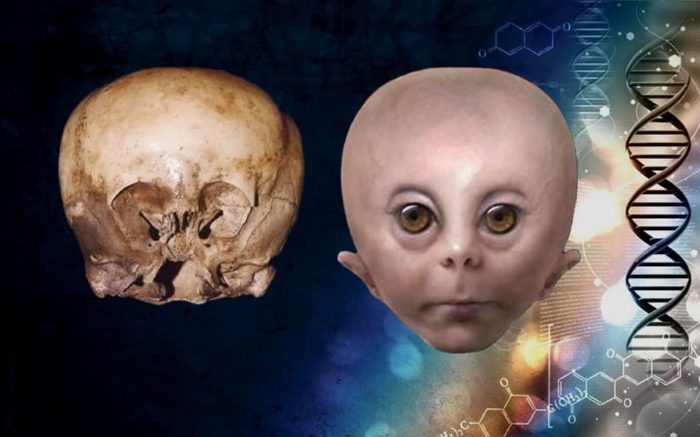
Will This Extraordinary “Starchild” Skull Prove the Existence of Extraterrestrial Life on Earth?
- By
- November 17, 2016
- September 28, 2021
- 10 min read
- 3
- Posted in
- Conspiracy Theory Analysis, Unsolved & Unexplained
The results of testing a very odd-looking skull dubbed the Starchild Skull is arguably the closest science — publicly disclosed science, at least — has yet come to answering the question of whether a human-extraterrestrial hybrid being has ever existed on Earth. DNA testing could prove it beyond doubt.
The skull has a fascinating, if somewhat unverified, provenance. It was discovered in the 1930s by a teenage girl on vacation in the Copper Canyon area of Mexico. She claims she went exploring and came across a long-abandoned mine tunnel in which she found a complete human skeleton lying on its back. Even more unusual was that to its side she saw a mound of dirt with an arm bone protruding from it attached to hand bones which appeared to be gripping the upper arm of the skeleton. When she dug into the mound, she unearthed a whole, smaller skeleton with a misshapen skull.

The Starchild Skull with artist’s impression of how it may have looked in life.
She gathered up the bones of both skeletons and hid them nearby, intending to return to them later in the vacation. Unfortunately, when she came back, there’d been a flash flood and they’d been washed away. However, lodged among debris along the flood path, she found the two skulls, the misshapen one having unfortunately become damaged in the lower facial area. She took them both home with her to El Paso, Texas, and kept them until the day she died, in the early 1990s.
At least that’s what she claimed were the circumstances of her discovery, but because she died without revealing more detail, such as where, exactly, the mine was located, researchers have had to take the provenance of the skulls on good faith. Although the girl did at some time coat the skulls in lacquer, thus preserving traces of the soil in which they were found, and tests have shown it to be of a type found in the general area where she claimed she made the discovery.
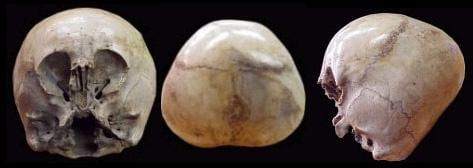
The Starchild Skull viewed from below, top, and side.
The skulls — including a separate fragment of jaw bone holding two molars belonging to the misshapen one — were passed to friends who, in 1998, handed them to Ray and Melanie Young, also of El Paso. Being a nurse and physiotherapist, Melanie recognised that the misshapen skull didn’t exhibit typical deformities and, after her medical colleagues couldn’t identify their cause, set about having it evaluated by experts to discover exactly what the skull was and why it looked the way it did. To that end, they enlisted the assistance of Lloyd Pye, an ‘alternative’ researcher and author on the evolution of Hominoids: modern great apes, humans, and extinct ancestors and relatives.
Lloyd became the custodian of the two skulls and director of the Starchild Project, which he and Melanie set up in 1999. Until his passing in 2013, he managed the scientific testing of the skulls, informing media and public of results as they came in.
Contents
But Isn’t It Just A Deformed Human Skull?
Skulls with abnormal features have been discovered many times before this one and upon examination have proven to be the result of known medical conditions or cultural practices. Search the Web and you’ll find no shortage of sceptics claiming that, in life, the Starchild suffered one of these.
Because of the abnormal bulging at the rear sides of the skull, most common is the claim that the person suffered from hydrocephaly. [1] To explain… A skull comprises plates of bone which, in babies, are held together by fibrous tissue called cranial sutures. These sutures are relatively flexible and open, but as a baby grows they close and eventually knit the bones together. However, in a baby with hydrocephaly, fluid accumulates inside the cranium — which is why it’s commonly called ‘water on the brain’ – and the pressure, acting on the weakest points, causes the soft open sutures to expand, forcing the head to enlarge.
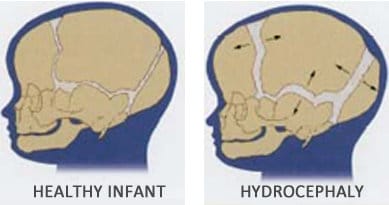
Expansion of sutures in hydrocephalic child
However, when the Starchild Skull was put through a CAT scan, it revealed no signs of hydrocephaly, only normal sutures. So, if not a condition unknown to medical science, the enlarged cranium has to be a natural anatomical feature.
Another claim commonly found on the Web is that the Starchild Skull shows signs of progeria, [2] an extremely rare genetic disorder causing rapid premature ageing in children and, ultimately, premature death: sufferers typically don’t survive beyond their mid-teens to early twenties.
Symptoms include stunted growth, hair loss, a small face with a receding jaw and pinched nose — all tending to become more marked as the child ages. Later on, among other conditions, they suffer wrinkled skin, cardiovascular problems, kidney failure, and protruding eyes with poor eyesight.
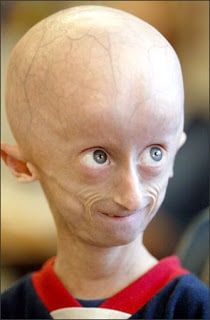
Child suffering from progeria.
Progeria has been suggested as the source of the Starchild Skull’s appearance chiefly because one of the most prominent abnormalities is a larger head in relation to the body. Not unlike hydrocephaly, this is caused by the gaps between the cranial plates — a child’s fontanelles or ‘soft spots’ — not closing up as they should. Also, the smaller facial area of the Starchild Skull (at least the facial area suggested by what remains) is not unlike the smaller facial area caused by progeria.
But, again, CAT scans have revealed a normal cranial bone structure in the Starchild Skull and no evidence of progeria.
So much for doubting the cause of the skull’s appearance on medical grounds; detractors also cast doubt on grounds of artificial skull modification. A number of cultures throughout history — a few even today — have practiced distorting the normal growth of a child’s skull while it’s still pliable by the deliberate application of force.
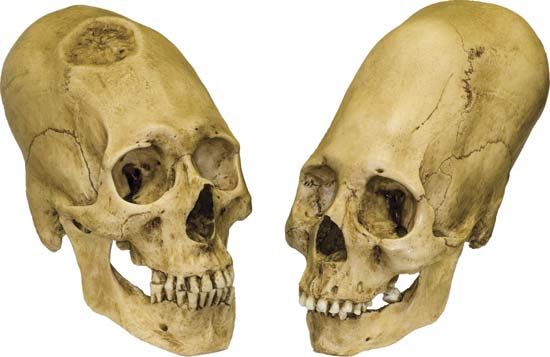
Peruvian elongated skulls: examples of artificial cranial modification
Because the rear of the Starchild Skull — the occipital bone — is relatively flat, it’s often claimed that a distorting force has been applied by a practice among indigenous peoples in Central and North America called cradleboarding. [3]
Cradleboarding is where a mother needing to carry her infant whilst performing some sort of task — whilst working, perhaps — straps the child to a wooden board she carries on her back. Continual contact of the child’s head with the board gradually flattens it. Though this is not so much deliberate as accidental skull modification: a by-product of the ‘baby backpacking’ method.
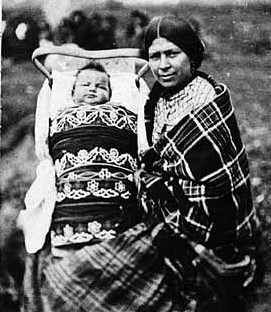
American Indian child in cradleboard
Interestingly, the adult female skull found with the Starchild Skull does in fact exhibit an unnatural flattening of the rear occipital bone typical of cradleboarding, so whatever the indigenous Mesoamerican civilisation she belonged to, it evidently practiced that method of carrying a child.
That fact may well have led some critics to claim that the Starchild was cradleboarded, as well. But a side-by-side comparison of the two skulls clearly shows the difference. Moreover, had the Starchild been strapped into a cradleboard, it would have had its head tilted so far forward as to have restricted its breathing and possibly died from asphyxiation.
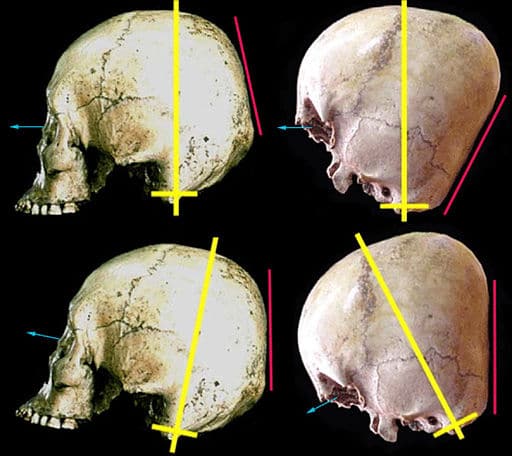
Human cradleboarded skull and Starchild Skull
Whatever sceptics of the Starchild Skull may still claim, the question of it having human deformities was answered conclusively in 2004 when the Starchild Project engaged a team of 11 medical specialists led by Dr. Ted Robinson, M.D., L.M.C.C., F.R.C.S, to thoroughly examine it. Collectively, these experts, all with PhDs, were proficient in fields such as Paediatrics, Radiology, Craniofacial Surgery, Ophthalmology (study of eyes), and Odontology (study of teeth). Over the course of nearly a year, they put the skull through numerous tests, including X-rays and CT scans, in an attempt to identify any known human illness or abnormality (or other causal factor) that would explain its appearance. They concluded that…
“The Starchild Skull was unlike any specimen in recorded medical history… its unusual characteristics are not the result of artificial cranial deformation.”
More Grey Matter Than A Human And Other Astonishing Anatomical Differences That Matter
Evidently, the Starchild was brainier than a human — literally. Meaning, the brain the skull once contained, whilst formed in left and right lobes like a human’s, had an overall volume of around 1600cc compared to a human child’s brain of 1200cc and human adult’s brain of 1400cc. Whether this superior brain size meant the Starchild possessed superior intelligence is, of course, impossible to answer.
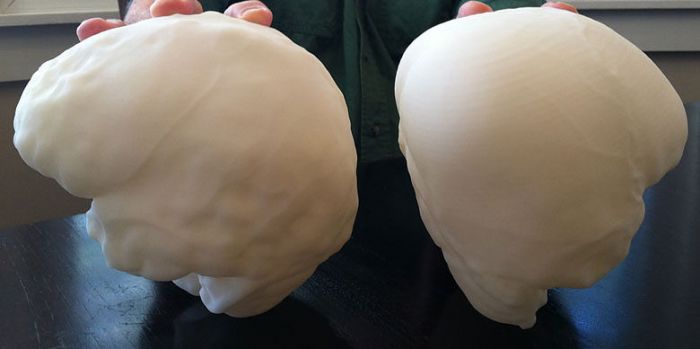
3D replicas of human brain and Starchild’s bigger brain (right) created from scans.
Scientists also examined the very bone the skull is made of and discovered more intriguing characteristics. To detect what chemical elements the bone contains, in 2003 it underwent Energy Dispersive Spectrometry (EDS) testing at Royal Holloway University, London. The female human skull found with the Starchild was tested at the same time and yielded results exactly as expected, but the Starchild Skull results showed an unusually high level of aluminium as well as abnormal amounts of other elements:
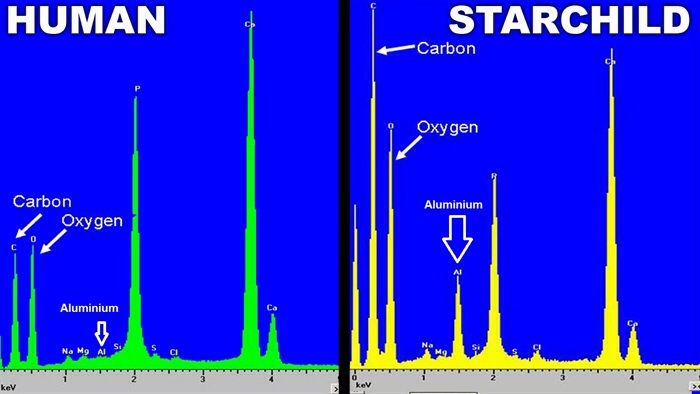
Chemical elements detected in the two skulls by spectrometric testing.
Aluminium is a very minor component of human bone; were a person’s skeleton to contain it in amounts equivalent to the Starchild’s, it would be fatal. (Although it’s been suggested that the high level could have been due to contamination by the saw blade with which the bone sample was cut; further testing is needed to verify the result.)
The physical properties and visual appearance of the bone offers yet more evidence of other-than-human origins. It’s around half as thick and half the weight of human bone, yet much tougher to cut. And under the microscope, it shows distinct differences in its internal structure; it’s more opaque than human bone, has a yellow tinge to it, and contains an unusual reddish residue.
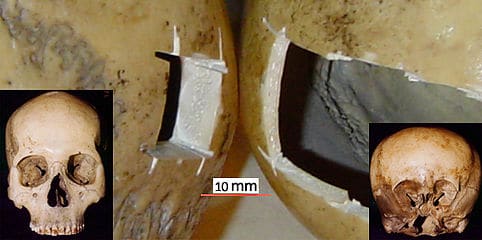
Starchild’s bone is 50% of the thickness of human bone… but much tougher.
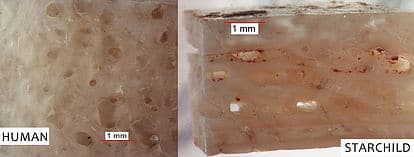
Differences in internal bone structure under the microscope. Note reddish residue in Starchild
Most intriguing of all, scanning electron microscope images show the bone to be shot through with strange fibres not known in human bone. It’s been hypothesized that these, like steel bars in concrete, perform a reinforcing function, which might explain the bone’s relative toughness. Further analysis of these fibres is needed to establish their composition.
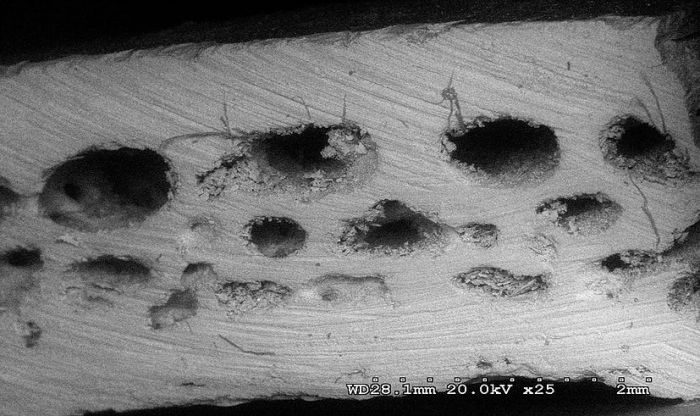
Electron microscope image of Starchild cranial bone showing strange fibres.
Though the lower jaw and many of the facial bones, unlike the cranial bones, of the Starchild were lost, there’s more than enough remaining from which scientists can determine other non-human characteristics. There’s a total absence of brow ridges and sinuses and the eye sockets deviate radically from the norm. Whilst the sockets are very symmetrical, front to back they’re less than half the depth of human eye sockets and the aperture through which the optic nerve passes is nearly an inch lower than a human’s. Any conjecture that the socket may therefore have housed not an eyeball but some other optical system is mitigated by the fact that attachment points for muscles that control eyeball movement are present on the inner surface of the sockets.
But it’s thought that if eyeballs of human size had occupied the sockets, they would have needed to protrude to the extent of risking severe damage. Therefore, the eyeballs were likely smaller than a human’s. Either way, bigger or smaller, they would have needed upper eyelids 3 to 4 times larger than normal to lubricate them.
Various artists’ impressions have been drawn or modelled over the years, depicting how the Starchild might have looked in life. In addition to the one at the top of the article, here are three more:
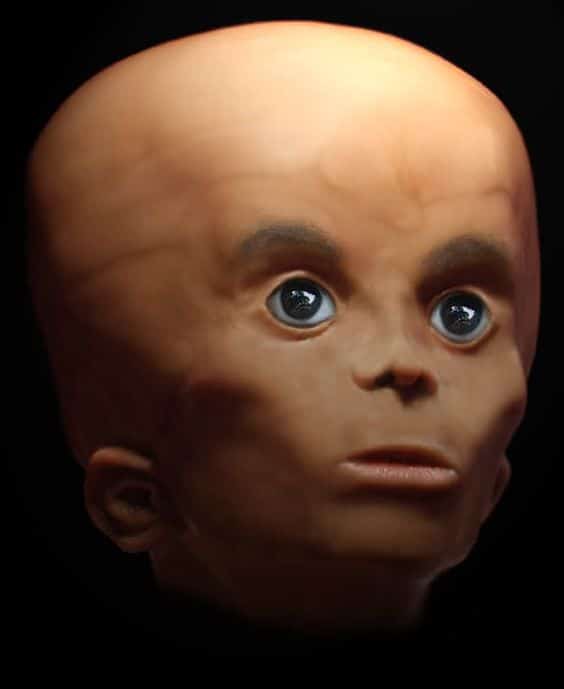
Artist’s impressions of the Starchild’s appearance in life.
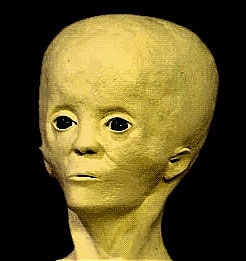
Artist’s impressions of the Starchild’s appearance in life.
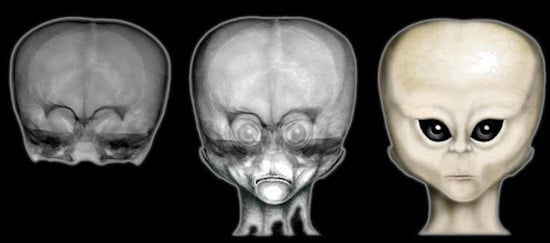
Artist’s impressions of the Starchild’s appearance in life.
Of course, a thorough investigation of the Starchild Skull and human skull found with it would not have been complete without establishing how old they are. They both underwent C14 radiocarbon dating in 2004 and each was found to be 900 years old plus or minus 40 years.
But what about the age of the Starchild when it died; have scientists been able to determine that, also? Unfortunately not. Whilst the name given to the Starchild Skull suggests it belonged to a child — someone up to the age of, say, 16 — due to contradictory evidence, their actual age at death remains an open question. The way the sutures have closed the bone plates in the cranium is indicative of an adult. An ‘adult’ hypothesis is also supported by the fact that the two molars in the fragment of maxilla (upper jaw) show a pattern of wear consistent with someone who reached maturity. However, X-rays of the fragment show two teeth already formed inside the jaw bone, ready to replace the two molars — in the way that adult teeth form before emerging to replace milk teeth in humans — which, the dental experts say, suggests the Starchild was around only 6 years old.
DNA: The Molecule of Extraterrestrial Life?
There’s one thing that could definitively answer the sixty-four-thousand-dollar question about the Starchild Skull: Is it human or extraterrestrial or a hybrid? Or is it even an undiscovered terrestrial species in some way genetically similar to humans? And that thing, of course, is DNA.
It’s useful, here, to understand that all of us have two types of DNA in our cells: mitochondrial (mtDNA) and nuclear (nuDNA). Nuclear DNA is found in cell nuclei and holds genetic material from both your mother and father; it’s responsible for giving you your unique, individual characteristics. Mitochondrial DNA is found in cell mitochondria and contains genetic material from your mother only. Significantly, mitochondrial DNA is inherited from your mother, grandmother, great-grandmother, great-great grandmother, and so on, duplicated through limitless generations, right back to your genetic origin.
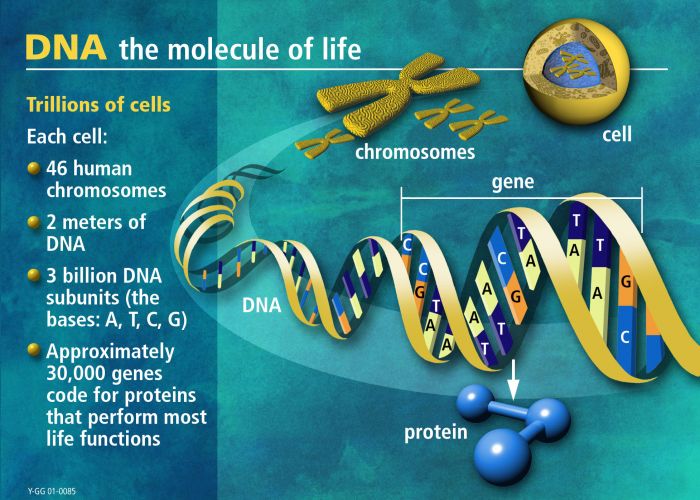
DNA: The molecule of life.
To date, the Starchild Skull has been subjected to several rounds of DNA testing. In 1999, there was an attempt to recover DNA using a lab equipped to recover forensic — classed as less than 50 years old – DNA but it was a failure due to contamination. What was really needed was a lab capable of recovering not forensic DNA but ancient DNA and capable of removing more contamination.
The first ancient DNA test was undertaken four years later, in 2003. It recovered human mitochondrial DNA but no nuclear DNA. This suggested a human mother and non-human father, leading to conjecture about the Starchild being a human-alien hybrid or, more likely, an unknown species with some genetic similarities to humans. Incidentally, the female human skull discovered with the Starchild Skull was found to be genetically unrelated to the Starchild, ruling out speculation that the female was the Starchild’s mother.
Not until 2010 was a further round of ancient DNA testing done with more sophisticated technology, wherein nuclear DNA was recovered for the first time. A sample was sent to the US National Institute of Health and run through their BLAST (Basic Local Alignment Search Tool) process for comparison to all other known DNA held in their database. The result? Some was similar to human DNA; some was not. Then, in 2011, mitochondrial DNA was recovered and, similarly, run through the BLAST process. Again, some was found to be similar to human DNA but large amounts were not. Were these results to be corroborated, it would show that the Starchild Skull belonged to an undiscovered species.
The most recent round of DNA testing, in 2012, led to some very intriguing results indeed. It recovered a fragment of the Starchild’s FOXP2 gene which, in humans, is linked to speech and thinking ability. This gene is identical in all humans and apes and has only one difference in monkeys, yet the Starchild’s was found to have a massive 56 differences — many more differences than the 21 between a human and an elephant and the 26 between a human and a frog. Yet more evidence, then, to support the hypothesis that the Starchild is non-human.
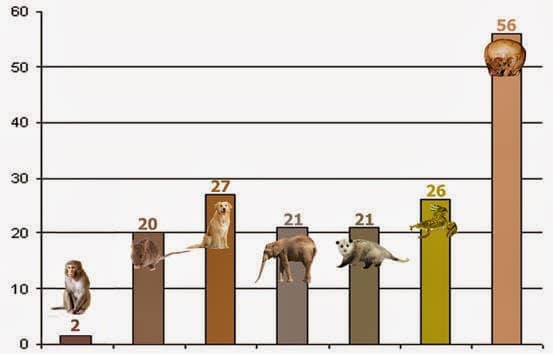
Differences in FOXP2 gene in animals and Starchild compared to humans
The science behind the research into the skull — particularly the DNA testing — is perhaps not the easiest of information to take in. Lloyd Pye therefore produced and narrated this well-worth-watching video to bring understanding of the scientific findings to the widest audience:
The Starchild Project, under Lloyd Pye’s leadership, has, despite limited resources, accomplished much over the last 17 years to get to the bottom of the Starchild Skull mystery, discovering scientific evidence that’s solid and credible. But much more testing is needed in order to duplicate and verify the DNA results; to satisfy the scientific community and confound the sceptics; and to answer that sixty-four-thousand-dollar question: Is it human, extraterrestrial, hybrid, or a ‘new’ earthly species? Tantalisingly, the weight of evidence so far seems to rule out human. The ultimate objective, though, is to have the entire genome extracted from the DNA and compare it to the human genome. Only then will that question be answered definitively. After Lloyd Pye’s passing, we can only hope that the Starchild Project finds the motivation and means — DNA testing is very, very expensive — to complete the research.
References
| ↑1 | What is Congenital Hydrocephalus? https://www.webmd.com/baby/congenital-hydrocephalus#1 |
|---|---|
| ↑2 | Progeria https://www.webmd.com/children/progeria#1 |
| ↑3 | The Native American Cradleboard, More Than Just a Baby Carrier, Prairie Edge, June 14th, 2011 https://prairieedge.com/tribe-scribe/the-native-american-cradleboard-more-than-just-a-baby-carrier/ |
Fact Checking/Disclaimer
The stories, accounts, and discussions in this article may go against currently accepted science and common beliefs. The details included in the article are based on the reports, accounts and documentation available as provided by witnesses and publications - sources/references are published above.
We do not aim to prove nor disprove any of the theories, cases, or reports. You should read this article with an open mind and come to a conclusion yourself. Our motto always is, "you make up your own mind". Read more about how we fact-check content here.
Copyright & Republishing Policy
The entire article and the contents within are published by, wholly-owned and copyright of UFO Insight. The author does not own the rights to this content.
You may republish short quotes from this article with a reference back to the original UFO Insight article here as the source. You may not republish the article in its entirety.

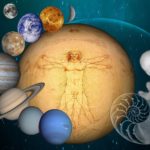
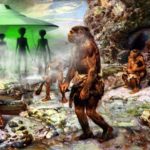
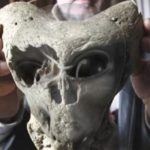
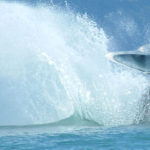
3 Comments
UFO Insight does not take responsibility for the content of the comments below. We take care of filtering profanity as much as we can. The opinions and discussion in the comments below are not the views of UFO Insight, they are the views of the individual posting the comment.
Newest comments appear first, oldest at the bottom. Post a new comment!
Where is the Skull and what has been done since Lloyds passing, update please.
Blesings in truth from Eire
In 2013 I was able to get the skulls back. I found a new investigator Chase Kloetzke. She took the skull to the osteology museum and compared the star child with 100s of skulls. She found that many of Lloyd’s claims were false.
She was able to find a lab that did ancient DNA analysis. In 2016 the DNA results concluded that the Starchild is human. In 2017 I repatriated the skull back to Mexico where it came from. Now the Starchild is home and can rest in peace
I think the graph of the genes should also include a cat.